
The Needs of Moose in Adirondacks and Beyond
By: John Davis – Adirondack Council Rewilding Advocate
Friday, March 18, 2022
As the first large-scale experiment in rewilding, the Adirondack Park has been remarkably successful. Many species nearly extirpated a century ago – including river otter, fisher, bobcat, black bear, beaver, common loon (Adirondack Council’s logo animal), bald eagle, and peregrine falcon –have rebounded wonderfully. Most of this wildlife recovery has been through natural recolonization, after killing was limited and some habitat allowed to regrow; and the latest of the charismatic animals to return has been the moose (Alces alces), the largest surviving member of the deer family.
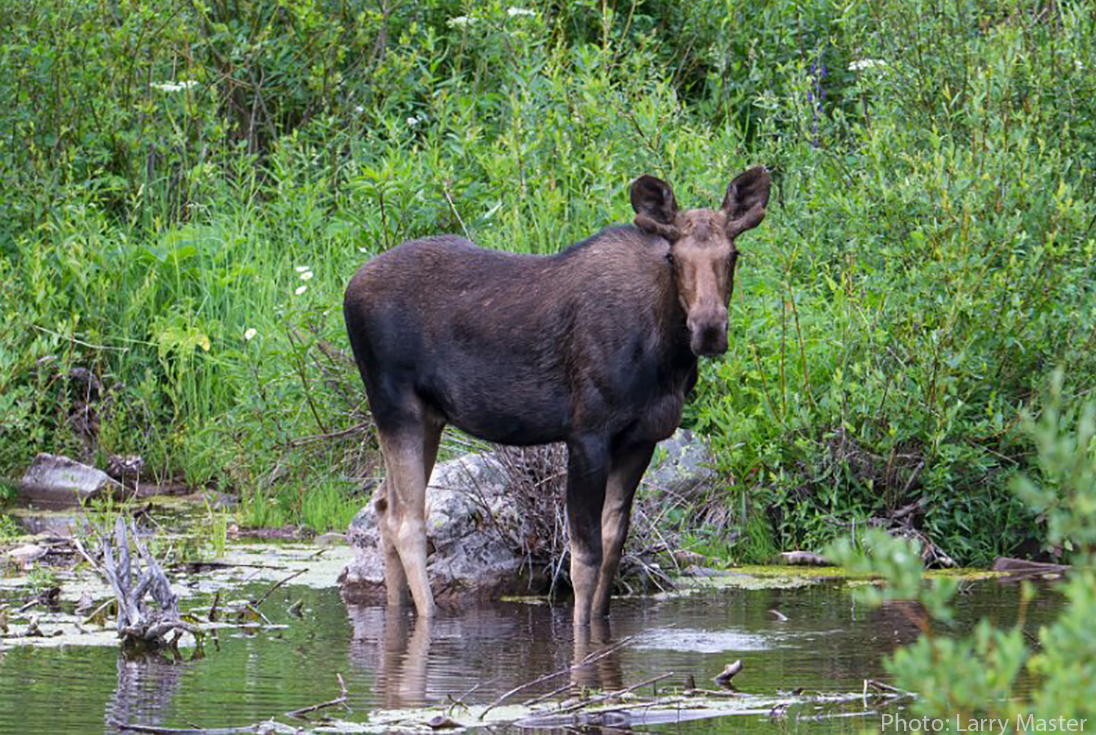
A Raven’s Eye Perspective on Moose in Our Region
As a recent article in New York Department of Environmental Conservation magazine The Conservationist by biologist David Kaplan explains, moose are slowly expanding in numbers across northern New York, perhaps numbering about 700 in the Adirondack Park. The long-term prospects for moose here are unsure, however, for this massive browser is a boreal species. Moose don’t like hot weather. A warming climate will tend to favor a smaller deer family member, white-tail deer, over moose.
As seen in Maine where their numbers have fallen lately, moose are highly susceptible to moose ticks, also called winter ticks. Paradoxically, where moose are densely populated due to abundant early succession forest and lack of top predators, moose are succumbing to cold in winter, after rubbing off their coats from agitation by ticks.
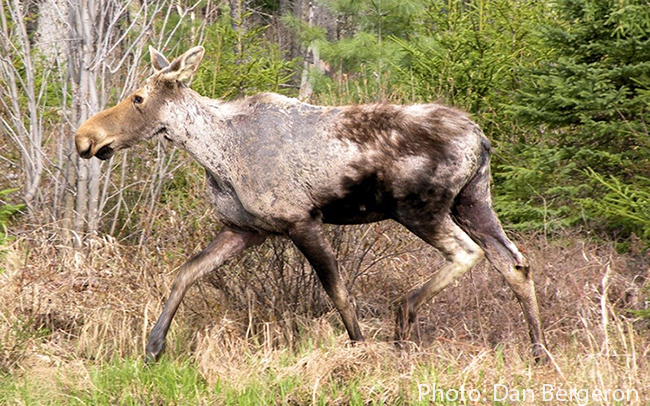 Adult moose with hair loss associated with high numbers of winter ticks
Adult moose with hair loss associated with high numbers of winter ticks
Moose are also susceptible to liver flukes and brainworm, both parasites carried by white-tail deer and passed to moose when the larger ungulates browse plants near deer scat. High deer numbers, then, may pose a challenge to long-term moose prosperity – another reason why top carnivores are needed in Northern Forests.
Moose becoming road-kill is already a major problem in parts of the US Northeast and southeast Canada. A sizable fraction of Moose mortality in northern New York each year is from being hit by motor vehicles while trying to crossroads. Safe wildlife crossings as well as lower – and enforced – speed limits at night could help lessen this ongoing roadkill tragedy. Road-kill, by the way, is a tragedy for both wildlife and people. Added to the billions of animals killed on roads every year, about 200 humans in the US die every year from collisions between the vehicles they are driving and ungulates trying to crossroads.
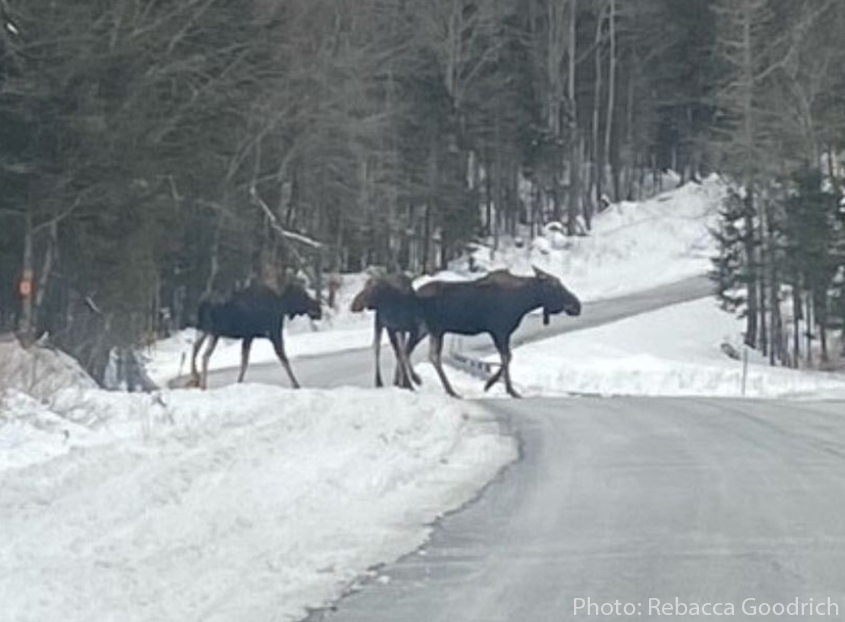
Regional, and even continental, habitat connectivity becomes ever more important as the climate warms and human numbers grow. For wide-ranging species like moose, dispersal events are important for maintaining genetic diversity and allowing demographic rescue. Moose are quite tolerant of human presence, but they are most likely to thrive and roam freely where extensive natural habitats of forest and wetland persist.
Being a well-connected and diverse landscape including boreal habitats, the Adirondack Park is the last best chance for New York to retain a mega-herbivore. Assuring a future for moose here means stabilizing climate; continuing to fully protect the Forest Preserve (which provides the secure habitat wide-ranging species need); encouraging ecologically sustainable forestry on large private lands (which can emulate natural disturbances like wind-throw and Beaver-clearing, and generate rich browse); strengthening habitat connections within and beyond Adirondack Park, including the Adirondack to Algonquin link (A2A), which Alice the Moose famously traversed years ago; and installing safe wildlife crossings where Moose are vulnerable to road-kill. Ultimately, when moose achieve carrying capacity in northern New York, apex predators could serve a role in keeping the herd strong and their numbers in check with plant communities.
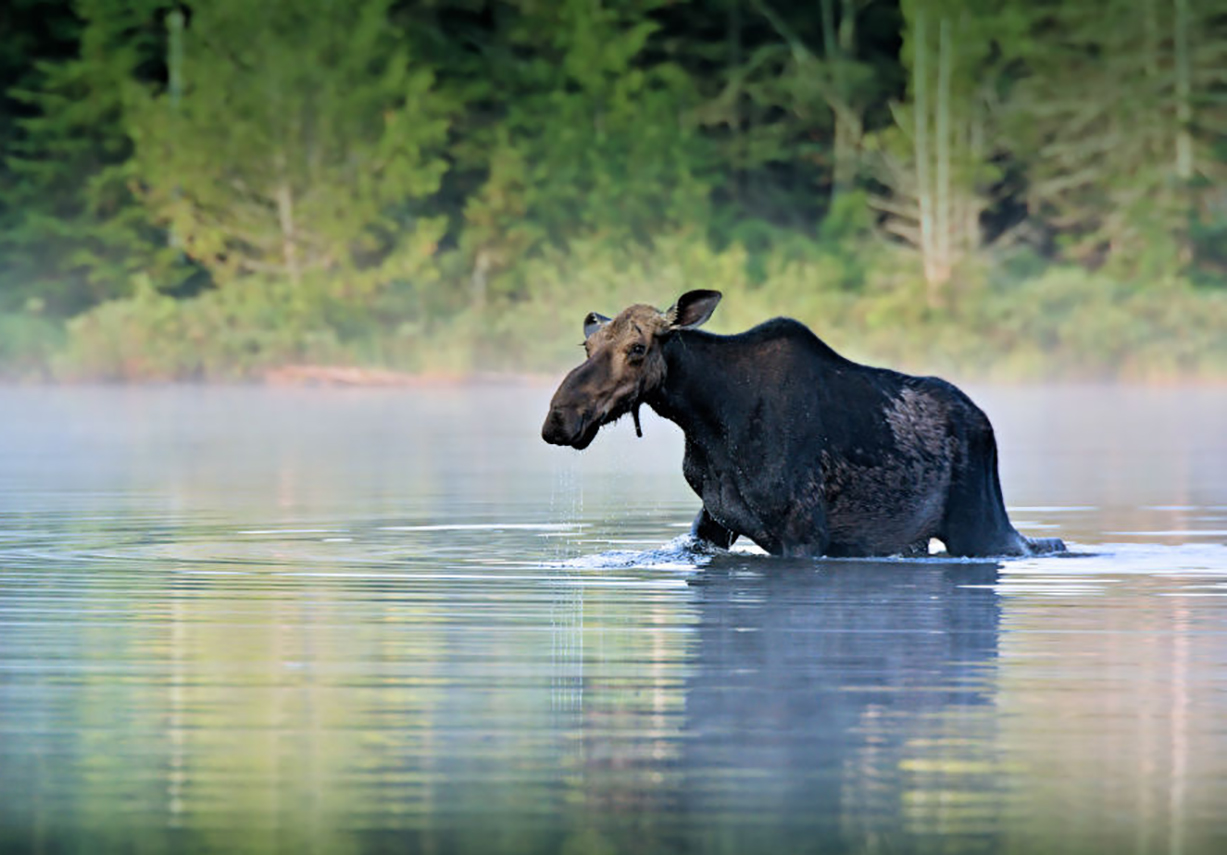 Alice the Moose
Alice the Moose
Where Moose Are Now
Moose have recolonized or rebounded in much of the northeastern US, from Maine to Massachusetts, after nearly being regionally extirpated a century ago. Moose returned from their remnant strongholds in northern Maine and southern Quebec and Ontario. Probably more because of recolonization patterns than because of habitat quality, moose are scarcer in New York than in New England. Until the explosions of winter tick numbers, anyway, moose were seemingly prospering most in Maine, New Hampshire, and Vermont, and particularly the northern halves of these cold states. In New York, moose are most abundant in north-central Adirondack Park.
Moose returned to New York’s North Country later than to New England, partly because we are bounded by broad valleys occupied by towns and farmlands, and remain lower in numbers here. Relative moose abundance on the heavily managed timber-company-owned lands of northern New England causes some people to assume moose prefer logged lands to unlogged lands. This is probably a misperception. Moose and many other so-called “game” species often thrive in recently logged areas, which after cutting see a profusion of young succulent vegetation. In a more natural landscape, though, moose, white-tail deer, ruffed grouse, wild turkey, and other animals that may seem to prefer managed timberlands to Forest Preserve would find plenty of early succession forest in areas where beavers, wind, ice, or floods have cleared trees.
So while we affirm that ecologically sustainable forestry can serve well moose and other species people love to see, let us not mislead the public by implying that these species need logging to thrive. Were that so, they’d have gone extinct long before humans arrived in North America, less than 20,000 years ago. In the long term, moose and most native species probably do best in landscapes functioning as nearly as possible to the ways they would had not Euro-American colonists disrupted natural flows and patterns. We have disrupted flows, obviously, though, so finding the right mix of public Forest Preserve lands and private sustainably managed lands is a good goal.
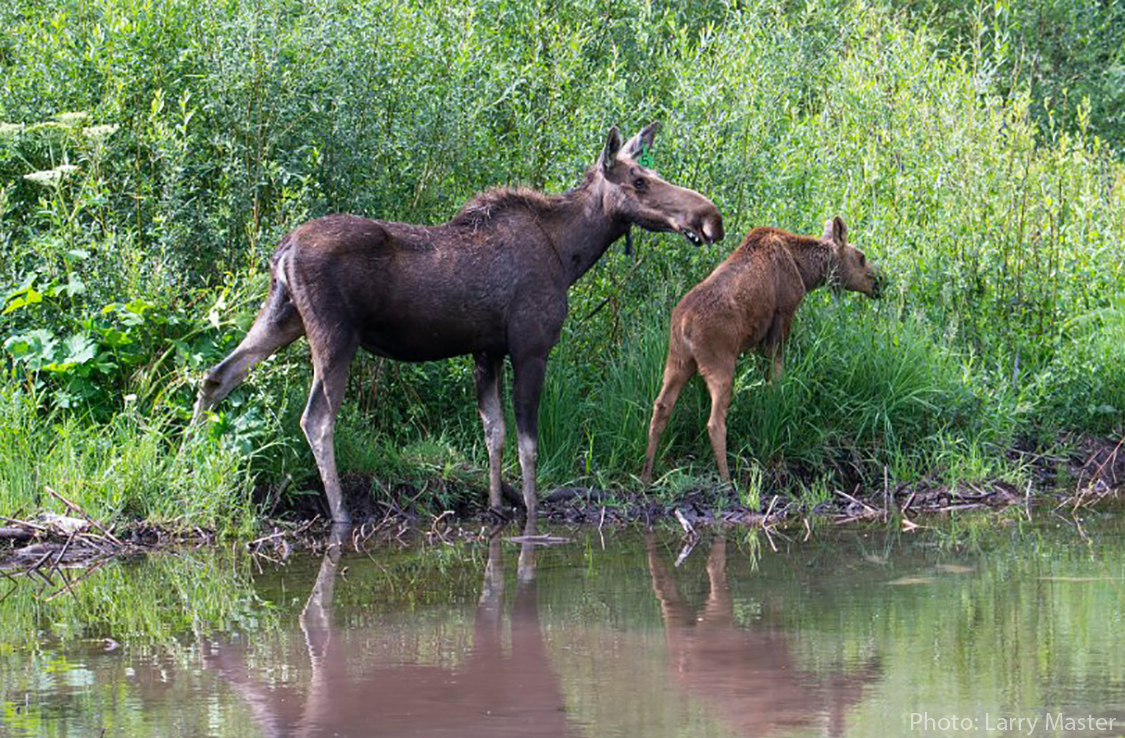
4 Things Moose Need Now
Specific steps toward keeping moose in the biota of the Adirondacks and Northern Appalachians include:
1. Slash carbon emissions and save old forests to avert climate chaos.
An overheating world is unkind to moose. Moose in the northeastern United States could soon see their remarkable recovery reversed if humans continue to pump greenhouse gases into the atmosphere. Last strongholds for the moose in the eastern US likely will include northern Maine, New Hampshire, Vermont, and New York’s Adirondack Park – but even these strongholds are at risk from climate disruption.
2. Install safe wildlife crossings on busy roads including inter-state and cross-provincial highways.
In Adirondack Park, safe wildlife crossings are especially needed on I-87 and Routes 3, 9, 22, 30, 73, and 86. Both underpasses and overpasses are needed, to serve different species. A few big wildlife bridges over I-87 would do much to educate motorists on road ecology issues, while also lessening the fragmenting damage of this major south-north highway.
3. Protect major wildways across the region.
In and around Adirondack Park, crucial wildways include the Algonquin Park to Adirondack Park connection (A2A, along the Frontenac Axis of Precambrian bedrock); the Adirondack to Tug Hill nexus across the Black River Valley; the Southern Lake Champlain Valley linking the Adirondacks with Vermont’s Green Mountains; and stream corridors wherever they remain intact or can be restored. For moose, the most critical of these regional wildways may be A2A, as suggested by ‘Alice the Moose” famously wandering from the middle of Adirondack Park to the southeast part of Algonquin Park fifteen years ago, essentially following the wildlife corridor previously mapped by biologists. For A2A to be kept as an intact wildlife corridor will require installing safe wildlife crossings on the busy roads near the Canada/US border, especially the highways in Canada running east-west near the border, and the Thousand Islands Parkway on the US side; and greatly accelerating the pace of private lands conservation, particularly by land trusts and particularly in St Lawrence and Jefferson Counties on the US side
4. Welcome the return of top carnivores to restore predator/prey and moose/deer balances.
As artists and biologists have long known, plant communities and even the herbivores who feed on them need top predators to maintain health.
Poet Robinson Jeffers long ago asked: "Who but the Wolf has whittled so fine the fleet feet of the Antelope?" Likely Jeffers was alluding to wolves pursuing pronghorn on the Great Plains, but the principle applies with other predator-prey relationships in other ecosystems. As abundant conservation biology literature now shows, although the presence of top carnivores may mean slightly fewer ungulates, the browsers themselves, and even more the plants they eat, need this predatory governance. Ultimately, to have healthy populations in healthy plant communities, moose need wolves.
Coyotes and black bears may occasionally take moose calves, but seldom if ever will they take full-grown healthy moose. Pumas, if welcomed home, would principally prey on white-tail deer – which would benefit moose – though they might occasionally also take moose calves. wolves, being pack hunters, are the one predator that can exercise strong control on moose numbers and behavior.
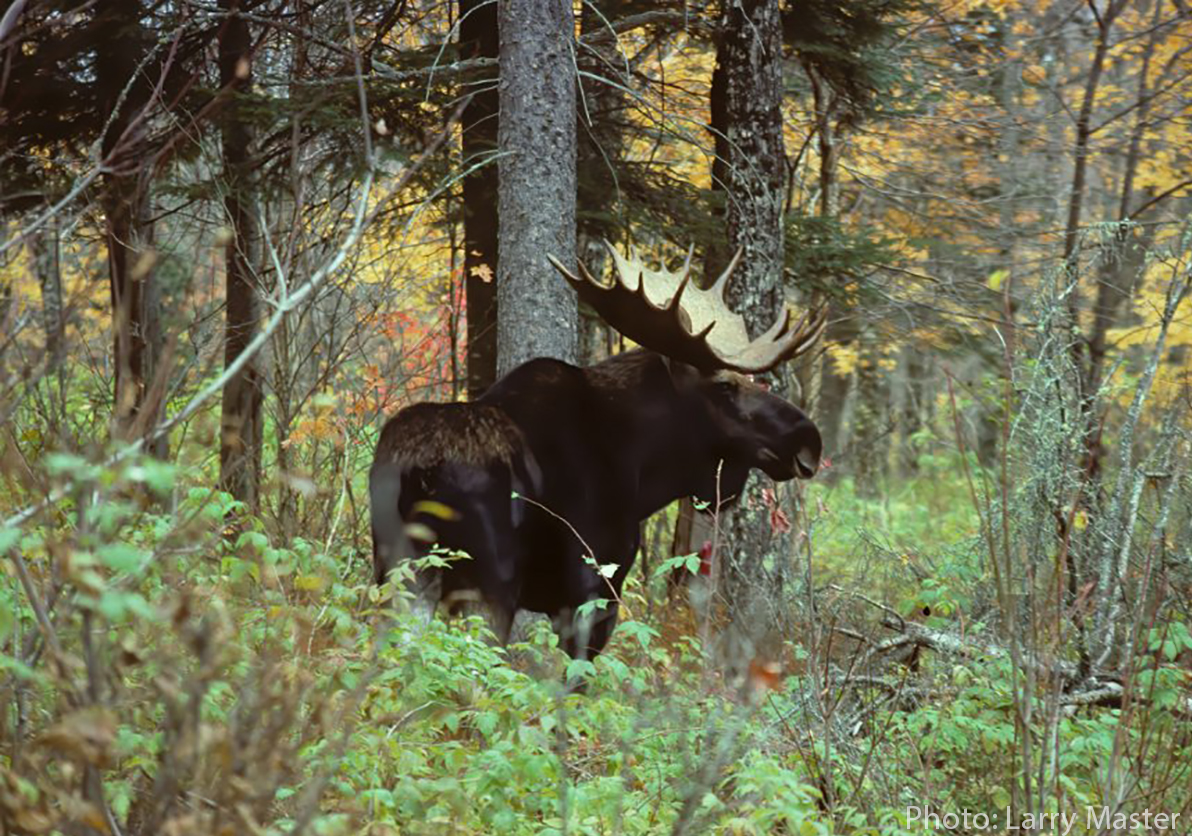
Moose as Icon
The Adirondack Park is a great rewilding success story, but it is unfinished. It is the wildest landscape in the US East, but it is not yet wild enough. Like the common loon in the Adirondack Council’s logo, the Moose symbolizes what we have achieved in Adirondack Park but also what is still far from secure. If we complete this great rewilding story – keeping the Park wild and connected, averting climate disruption, welcoming home missing species -- moose will be more abundant in our grandchildren’s lives than they are now, and our grandchildren may occasionally feel the thrill of seeing wolf tracks in the snow close on the trail of an old bull moose.
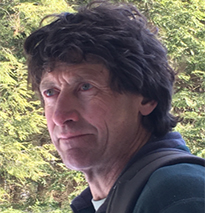
John Davis returned to the Adirondack Council staff in 2021 as its Rewilding Advocate. He is also the Director of The Rewilding Institute. In these complementary positions, John promotes the protection and restoration of wilderness and wildlife throughout Adirondack Park and beyond. John has also worked as a land steward with Adirondack Land Trust, Eddy Foundation, and Northeast Wilderness Trust, especially in Split Rock Wildway – a wildlife corridor linking Lake Champlain with the High Peaks. John explores wild places by hiking, paddling, and cross-country skiing. His long conservation treks are described in his book Big, Wild, and Connected: Scouting an Eastern Wildway from Florida to Quebec and in the TrekWest film Born to Rewild. John lives with his wife Denise Wilson-Davis in Essex, NY.




